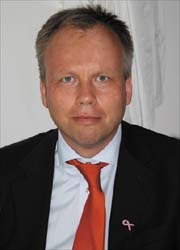Tomorrow's imaging on today's horizon
Professor Mats Danielsson, at the Royal Institute of Technology and Sectra, in Sweden, explains what tomosynthesis means to his company today, and soon, to mammography for the future
"Tomosynthesis is a hot topic in all the companies involved in mammography", Professor Danielsson pointed out. "But whereas they are developing more or less the same thing, Sectra has a totally different concept - photon-counting - a unique technology that, for the first time, processes X-rays one by one."

So we have less noise and radiation compared with common systems that unselectively merge many and different kinds of photons with noise. Along with the electronic noise reduction we also receive more information from each X-ray. This data is acquired with a slit-imaging detector (it has only thin slits to let the radiation through), which moves from left to right to collect the data. So we are talking about a very sophisticated system, which only Sectra is developing.
‘Photon-counting tomosynthesis is a result of research in high-end physics. When researchers at Fermilab found the long missing sixth quark, the so-called top quark and a fundamental constituent of matter, that was only possible because of a new, very sensitive detector. This sensor uses similar technology to the sensor we now use for photon-counting mammography. So, I have shifted my experience from CERN into mammography development. Obviously, my advantage is that I work part-time, and independently for Sectra, and part-time at the Royal Institute of Technology in Stockholm, so I can match my experiences from both sides – as is the case for the tomosynthesis project.
‘There are currently prototypes of the photon-counting tomosynthesis system for research purposes. Our focus is for example on the comparison of MR and tomosynthesis. At this stage, we are convinced that tomosynthesis can definitely compete with MR, because MR is expensive, and the resolution of tomosynthesis is far better. Even considering the radiation, which you don’t have with MR, tomosynthesis has advantages, because the radiation is low and the images excellent. It’s the same with CT - I think it cannot keep up with the resolution of tomosynthesis.’
20.06.2007











